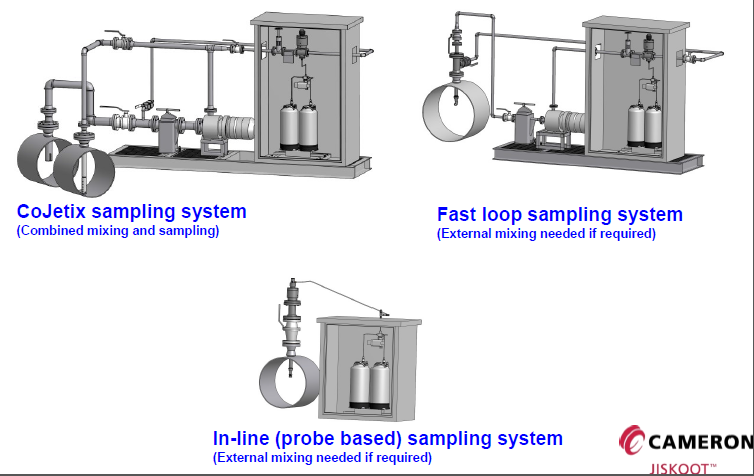Sampling Equipment
Sampling of Hydrocarbon Liquids and Gasses is performed against one of four international standards:
They are
1. ISO 3171
2. IP 6.2
3. API 8.2
4. ASTM D4177
There are two main types of sampling systems, namely probe based systems and bypass loop sampling systems.
In probe-based systems the sample is taken inside the pipeline and in a bypass loop system the sample is taken from a 1″ or 2″ bypass loop flowing isokinetically with the main pipeline flow.
Jiskoot Hydro-Carbon Sampling Systems
Probe based systems tend to be lower cost and accuracy and have a higher measurement uncertainty and maintenance cost. They also have a higher dead volume which can lead to batch cross contamination.
Bypass loop systems tend to be more expensive, but more accurate, easier to maintain and have a lower measurement uncertainty and dead volume.
Depending on the application, there are several factors which must be taken into consideration when specifying and designing a suitable sampling system
It must be stressed that in In a typical sampling application, the volume analysed is between 1 and 300 billionth of the total batch. When the custody transfer and batch quality is determined by such a small sample it is vital that it is representative of the fluids being sampled.
The standards define a number of steps that need following to ensure successful sampling:
Homogeneity of pipeline contents.
To ensure that the sample is representative of the fluids flowing in the pipeline the sample must be extracted from a point that is representative of a cross section of the pipeline. This may require mixing. The standards include formula (annexe A and B) to calculate the mixing in a pipeline to assess the suitability of a location for sampling. This calculation should be performed for the worse case condition (minimum flow rate, viscosity and density
Location of the sampling system in relation to the custody transfer point.
Ideally this should be at the custody transfer point, but in many cases (such as marine loading/unloading) it is not possible to do this and ensure sufficient mixing at all flow rates. Samples taken at these locations often do not comply with the standards. In these applications the flow turndown also prohibits the use of a static mixer and causes problems with flow resolution. The sampling system can be installed at a more suitable location and the line-fill sampled
Extraction of a flow proportional and representative sample.
The flow rate in the main pipeline may vary and the sampling system must operate flow proportionally to ensure representivity. Every sample grab must be highly repeatable (1cc +/- 2%) irrespective of changes in density, viscosity, pressure or temperature to avoid biasing the batch sample. The total batch sample should comprise enough small grabs to represent the whole batch (for crude oil normally at least 10,000 – 1cc grabs (10 litres). The sampling system performance should be monitored and reported during the batch.
Correct sample handling and mixing.
Sample grabs are discharged into a sample receiver which should be capable of maintaining the sample without any loss of light-ends. The receiver should have no voids or water traps and it is preferable that it is portable to minimise the possibility of errors or contamination occurring in the field. Before a sub-sample is drawn for analysis in the laboratory, the contents of the sample receiver must be mixed to ensure that water has not settled during the sampling process.
Laboratory analysis.
The laboratory analysis should be conducted in accordance with recognised procedures and standards. The sampling standards recommend Karl Fischer titration as the preferred method of water measurement.
Prove the system.
In order to confirm the performance of a sampling system it may be necessary to prove the system performance by water injection. The standards define a procedure and method of injecting a known volume of water into a pipeline and using the sampling system to withdraw samples to measure the injected water. This process can be independently witnessed and certified to the satisfaction of all parties concerned. The test of the performance of any sampling equipment is the performance validation by water injection and this is often used as a crucial performance guarantee requirement in system specifications.
